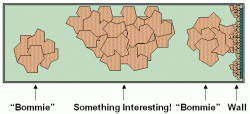pmb_67
Fish Fanatic
Hi all, me again.
Just wondering if anyone's got any tips or advice on aquascaping live rock... I've got a few plans in terms of layout, like trying for one or two caves, ledges, arches etc. and it's how to build these that I'm looking for help with, along these lines:
1) I'm taking it as read that the rock goes in first and sits on the tank floor, rather than balancing on the sand bed and being undermined by any burrowing tank inhabitants later on. A few OFS's are suggesting using egg-crate to avoid the potentially sharp rock scratching the base - anyone support this approach, or object to it? Am wondering if small sheets of acrylic would make better bases as they don't have the little square pockets to fill up with sand and create dead spots in the substrate.
2) When building, should I just pile rocks on top of each other? Or once I'm happy with the layout should I stick them together? I have a stick of "Holdfast" which claims to set underwater - not sure what colour it sets though, am looking at D-D's purple-drying one as an alternative.
3) If I'm building a pinnacle or arch, should I reinforce it? Spoke to a guy in my LFS a while back and he said he'd built a frame out of acrylic rod for his rockscape - anyone else tried this? Anyone had any bad experiences along this line?
Thanks all,
Paul
Just wondering if anyone's got any tips or advice on aquascaping live rock... I've got a few plans in terms of layout, like trying for one or two caves, ledges, arches etc. and it's how to build these that I'm looking for help with, along these lines:
1) I'm taking it as read that the rock goes in first and sits on the tank floor, rather than balancing on the sand bed and being undermined by any burrowing tank inhabitants later on. A few OFS's are suggesting using egg-crate to avoid the potentially sharp rock scratching the base - anyone support this approach, or object to it? Am wondering if small sheets of acrylic would make better bases as they don't have the little square pockets to fill up with sand and create dead spots in the substrate.
2) When building, should I just pile rocks on top of each other? Or once I'm happy with the layout should I stick them together? I have a stick of "Holdfast" which claims to set underwater - not sure what colour it sets though, am looking at D-D's purple-drying one as an alternative.
3) If I'm building a pinnacle or arch, should I reinforce it? Spoke to a guy in my LFS a while back and he said he'd built a frame out of acrylic rod for his rockscape - anyone else tried this? Anyone had any bad experiences along this line?
Thanks all,
Paul


